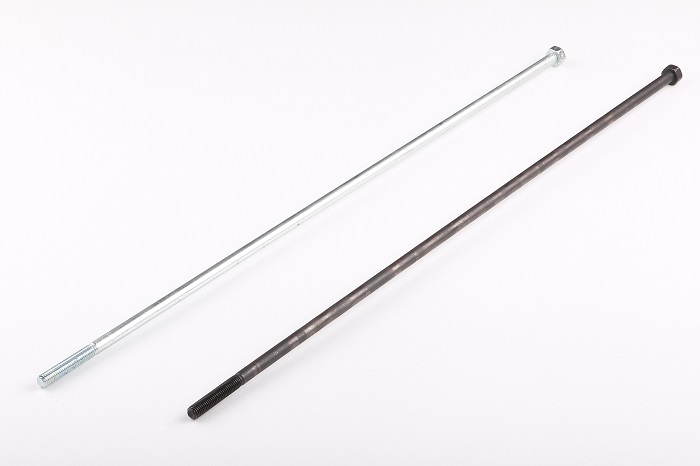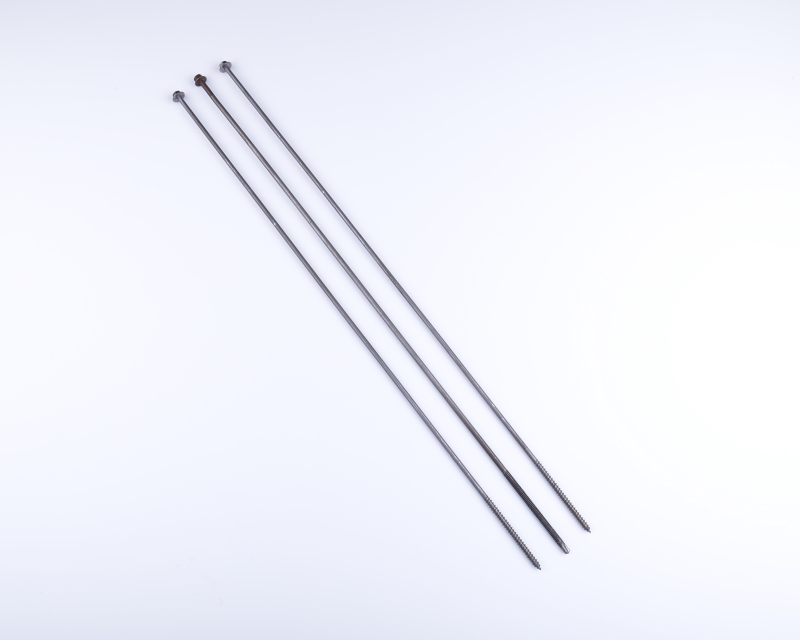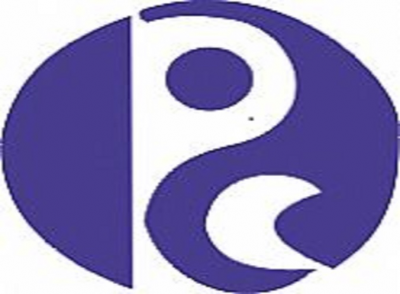整直加工
 整直加工 螺絲整直加工是一種將螺絲或螺栓進行加工,使其變得更加直和精確的過程。這是為了確保螺絲在使用時能夠正確地配合其他零件,以達到安全和可靠的連接。
整直加工 螺絲整直加工是一種將螺絲或螺栓進行加工,使其變得更加直和精確的過程。這是為了確保螺絲在使用時能夠正確地配合其他零件,以達到安全和可靠的連接。
螺絲整直加工通常包括以下步驟:
選擇合適的螺絲:首先,需要選擇適合的螺絲或螺栓,確保其尺寸和特性符合所需的應用要求。
清潔和檢查:螺絲可能會在製造過程中積累污垢或有缺陷,因此需要將其清潔並進行檢查,以確保表面平整和無明顯的缺陷。
整直加工:整直加工可以通過機械方法或熱處理來完成。機械整直可以使用專門設計的機器,例如整直機,以使螺絲變得更加直。熱處理則通常涉及將螺絲加熱至一定溫度,然後冷卻以去除不正確的形狀。
測量和檢驗:整直後的螺絲需要進行測量和檢驗,以確保其尺寸和形狀在可接受的範圍內。這通常涉及使用測量工具,例如千分尺或光學測量儀器,以確保螺絲的精度。
儲存或交付:整直後的螺絲可以儲存起來以供以後使用,或者直接交付到裝配線進行安裝。
整直螺絲是確保機械組件的正確運作非常重要的一步,特別是在需要高精度和可靠性的應用中,如航空、汽車、建築和製造業。
當進行螺絲整直加工時,可能會有一些進一步的細節和考慮事項,這些包括:
整直方法:整直可以使用不同的方法來完成,包括機械整直、熱整直和冷整直。選擇適當的整直方法取決於螺絲的材料和尺寸,以及所需的精度。
整直設備:整直機通常是專門設計用於螺絲整直的設備,它們可以自動處理大量的螺絲。這些機器通常具有多個滾輪或滾筒,用於將螺絲通過並整直它們。
熱整直:對於某些材料和螺絲尺寸,熱整直可能是更適合的選擇。它通常涉及將螺絲加熱至一定溫度,然後冷卻以消除變形。
質量控制:在整直過程中,質量控制是至關重要的。測量和檢驗螺絲的尺寸和形狀是確保它們符合規格的一部分。不合格的螺絲需要進一步處理或丟棄。
削減:在整直過程中,螺絲的一部分可能會被削減以達到所需的尺寸和形狀。這可能需要精確的切割工具和設備。
表面處理:有時,整直後的螺絲可能需要進一步的表面處理,例如鍍層或磨光,以提高其耐腐蝕性或外觀。
總之,螺絲整直加工是確保螺絲符合特定要求的重要過程,並且在各種應用中都具有廣泛的使用。通過選擇適當的整直方法和設備,以及實施嚴格的質量控制,可以確保整直後的螺絲具有高精度和可靠性。
當進一步探討螺絲整直加工時,以下是一些重要的注意事項和應用領域:
材料選擇:不同的螺絲需要不同的整直方法,具體取決於其材料。常見的材料包括鋼、不銹鋼、黃銅和鋁等。每種材料都具有其獨特的特性,需要適當的整直處理。
精度要求:某些應用需要非常高的螺絲精度,例如航空航天和醫療設備製造。在這些情況下,整直過程可能需要更嚴格的控制,以確保每個螺絲都符合非常嚴格的規格。
生產效率:整直過程的自動化可以提高生產效率,特別是在需要大量螺絲的情況下。自動整直機可以持續處理大量螺絲,節省時間和人力。
廣泛的應用:螺絲整直加工不僅適用於一般工業製造,還適用於許多其他領域,例如建築、交通運輸、電子、能源和設備維護等。
安全性和可靠性:螺絲整直是確保機械和結構元件的安全性和可靠性的重要步驟。不正確的螺絲可能會導致結構失效或機械故障,因此整直過程必須受到嚴格監控和控制。
總的來說,螺絲整直加工是製造和建造過程中的關鍵步驟之一,它確保了螺絲的精確度和可靠性,有助於確保裝配的組件具有高品質、安全和可持續的性能。不同的應用可能需要不同程度的整直和精度,因此在選擇整直方法和設備時需要根據具體需求進行評估。
當談到螺絲整直加工時,以下是更多相關的信息和考慮事項:
整直工藝:整直過程可以通過不同的工藝來實現,包括滾壓、壓鉚、冷整直和熱整直。滾壓是一種常見的整直方法,它使用滾筒或滾輪來塑造螺絲的外形,使其變得更加直線。壓鉚則涉及在螺絲上施加壓力以整直它。冷整直是在室溫下進行的整直過程,而熱整直則需要將螺絲加熱到一定溫度,然後整直它。
整直前處理:有時,螺絲需要經過一些前處理步驟,例如除銹、去油或退火,以確保整直過程的成功。這些前處理步驟可以改善材料的可加工性並減少整直過程中的壓力。
螺絲尺寸:不同尺寸的螺絲需要不同的整直方法和設備。小型螺絲可能需要不同的整直方法,以確保它們的精確度和直度。
自動化和機器設備:在大規模生產中,通常會使用自動化整直機器,以提高效率並確保一致的品質。這些機器可以自動銷螺絲並進行整直,並且可以通過設定參數來實現精確的整直。
成本和效益分析:在整直過程中,需要考慮成本和效益。進行成本效益分析可以幫助您確定是否有必要進行整直,以及選擇最合適的整直方法和設備。
質量控制和檢測:確保整直後的螺絲符合規格非常重要。這需要使用精密的測量工具和檢測設備來檢查螺絲的尺寸和形狀。
環保和可持續性:在整直過程中,需要考慮環保因素,包括廢棄物處理和資源使用。許多製造企業致力於降低整直過程的能源消耗和環境影響。
總之,螺絲整直加工是一個多方面的過程,其目的是確保螺絲具有所需的精確度和直度,以滿足各種應用的要求。在整直過程中,需要仔細考慮材料、尺寸、工藝、設備、質量控制和成本效益等因素,以確保最佳的結果。
Screw straightening is the process of machining screws or bolts to make them straighter and more precise. This is to ensure that the screws can properly fit with other parts when used to achieve a safe and reliable connection.
Screw straightening usually includes the following steps:
Select the right screw: First, you need to select the right screw or bolt, ensuring that its size and characteristics match the required application requirements.
Cleaning and Inspection: Screws may have accumulated dirt or be defective during the manufacturing process, so they need to be cleaned and inspected to ensure the surface is smooth and free of obvious defects.
Straightening: Straightening can be accomplished by mechanical methods or heat treatment. Mechanical straightening can use specially designed machines, such as straightening machines, to make screws straighter. Heat treatment usually involves heating the screw to a certain temperature and then cooling it to remove incorrect shape.
Measurement and Inspection: Straightened screws need to be measured and inspected to ensure that their size and shape are within acceptable limits. This usually involves using a measuring tool, such as a micrometer or optical measuring instrument, to ensure the accuracy of the screw.
Storage or Delivery: Straightened screws can be stored for later use or delivered directly to the assembly line for installation.
Straightening screws is a very important step in ensuring the correct operation of mechanical components, especially in applications that require high precision and reliability, such as aerospace, automotive, construction and manufacturing.
There may be some further details and considerations when performing screw straightening, these include:
Straightening methods: Straightening can be accomplished using different methods, including mechanical straightening, hot straightening, and cold straightening. Choosing the appropriate straightening method depends on the material and size of the screw, as well as the accuracy required.
Straightening equipment: Straightening machines are typically equipment specifically designed for straightening screws, and they can handle large quantities of screws automatically. These machines usually have multiple rollers or rollers that pass the screws through and straighten them.
Heat straightening: For certain materials and screw sizes, heat straightening may be a more suitable option. It usually involves heating the screw to a certain temperature and then cooling it to eliminate distortion.
Quality Control: Quality control is crucial during the whole process. Measuring and inspecting the size and shape of screws is part of ensuring they meet specifications. Unqualified screws need to be further processed or discarded.
Cutting: During the straightening process, part of the screw may be cut back to achieve the desired size and shape. This may require precise cutting tools and equipment.
Surface Treatment: Sometimes straightened screws may require further surface treatment, such as plating or polishing, to improve their corrosion resistance or appearance.
In summary, screw straightening is an important process to ensure that screws meet specific requirements and is widely used in a variety of applications. By selecting appropriate straightening methods and equipment, and implementing strict quality control, you can ensure high precision and reliability of straightened screws.
When looking further into screw straightening, here are some important considerations and application areas:
Material Selection: Different screws require different straightening methods, depending on their material. Common materials include steel, stainless steel, brass, and aluminum. Each material has its own unique properties and requires proper straightening.
Accuracy requirements: Certain applications require very high screw accuracy, such as aerospace and medical device manufacturing. In these cases, the straightening process may require tighter controls to ensure that each screw meets very strict specifications.
Production efficiency: Automation of the straightening process can improve production efficiency, especially when a large number of screws are required. The automatic straightening machine can continuously handle a large number of screws, saving time and manpower.
Wide range of applications: Screw straightening is not only suitable for general industrial manufacturing, but also for many other fields, such as construction, transportation, electronics, energy and equipment maintenance, etc.
Safety and Reliability: Screw straightening is an important step in ensuring the safety and reliability of mechanical and structural elements. Incorrect screws can cause structural failure or mechanical failure, so the straightening process must be strictly monitored and controlled.
Overall, screw straightening is one of the key steps in the manufacturing and construction process, ensuring screw accuracy and reliability, helping to ensure high-quality, safe and sustainable performance of assembled components. Different applications may require varying degrees of straightening and precision, so selection of straightening methods and equipment needs to be evaluated based on specific needs.
When it comes to screw straightening, here’s more information and considerations:
Straightening process: The straightening process can be achieved through different processes, including rolling, riveting, cold straightening and hot straightening. Rolling is a common straightening method that uses rollers or wheels to shape the screw to make it more straight. Press riveting involves applying pressure on the screw to straighten it. Cold straightening is a straightening process performed at room temperature, while hot straightening requires heating the screw to a certain temperature and then straightening it.
Pre-straightening treatment: Sometimes, screws need to undergo some pre-treatment steps, such as rust removal, degreasing or annealing, to ensure the success of the straightening process. These pre-treatment steps improve the material's processability and reduce stress during straightening.
Screw size: Different sizes of screws require different straightening methods and equipment. Small screws may require different straightening methods to ensure their accuracy and straightness.
Automation and Machinery: In large-scale production, automated straightening machines are often used to increase efficiency and ensure consistent quality. These machines can automatically pin and straighten screws, and parameters can be set to achieve precise straightening.
Cost and benefit analysis: During the integration process, costs and benefits need to be considered. Conducting a cost-benefit analysis can help you determine whether straightening is necessary and select the most appropriate straightening method and equipment.
Quality Control and Inspection: It is important to ensure that straightened screws meet specifications. This requires the use of precision measuring tools and inspection equipment to check the size and shape of the screws.
Environmental protection and sustainability: During the entire process, environmental factors need to be considered, including waste disposal and resource use. Many manufacturing companies are committed to reducing the energy consumption and environmental impact of their entire processes.
In summary, screw straightening is a multifaceted process whose purpose is to ensure that screws have the required precision and straightness to meet the requirements of various applications. During the straightening process, factors such as materials, dimensions, workmanship, equipment, quality control and cost-effectiveness need to be carefully considered to ensure the best results.

